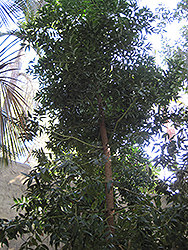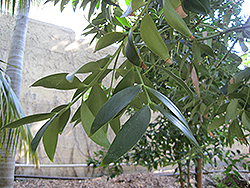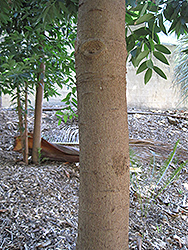It's all about ...
plants

Height: 80 feet
Spread: 20 feet
Sunlight:
![]()
Hardiness Zone: 8b
Other Names: Dammar Pine, syn. Agathis palerstonii
Description:
A tall, upright conifer, eventually growing to 80 feet or more, featuring leathery, dark green elliptic foliage on branches that are tightly held to a vertical trunk; a magnificent landscape accent or street planting in warmer climates
Ornamental Features
Queensland Kauri is primarily valued in the landscape for its rigidly columnar form. It has attractive dark green evergreen foliage which emerges yellow in spring. The glossy pointy pinnately compound leaves are highly ornamental and remain dark green throughout the winter. The brown fruits are held in cones from late summer to early fall. The fruit can be messy if allowed to drop on the lawn or walkways, and may require occasional clean-up. The peeling brown bark adds an interesting dimension to the landscape.
Landscape Attributes
Queensland Kauri is an evergreen tree with a strong central leader and a narrowly upright and columnar growth habit. Its average texture blends into the landscape, but can be balanced by one or two finer or coarser trees or shrubs for an effective composition.
This tree will require occasional maintenance and upkeep, and can be pruned at anytime. It is a good choice for attracting birds and squirrels to your yard. It has no significant negative characteristics.
Queensland Kauri is recommended for the following landscape applications;
- Accent
- Shade
- Vertical Accent
Planting & Growing
Queensland Kauri will grow to be about 80 feet tall at maturity, with a spread of 20 feet. It has a high canopy of foliage that sits well above the ground, and should not be planted underneath power lines. As it matures, the lower branches of this tree can be strategically removed to create a high enough canopy to support unobstructed human traffic underneath. It grows at a medium rate, and under ideal conditions can be expected to live to a ripe old age of 150 years or more; think of this as a heritage tree for future generations! This is a self-pollinating variety, so it doesn't require a second plant nearby to set fruit.
This tree should only be grown in full sunlight. It prefers to grow in average to moist conditions, and shouldn't be allowed to dry out. It is not particular as to soil type or pH, and is able to handle environmental salt. It is highly tolerant of urban pollution and will even thrive in inner city environments. This species is not originally from North America..
This plant is not reliably hardy in our region, and certain restrictions may apply; contact the store for more information.


